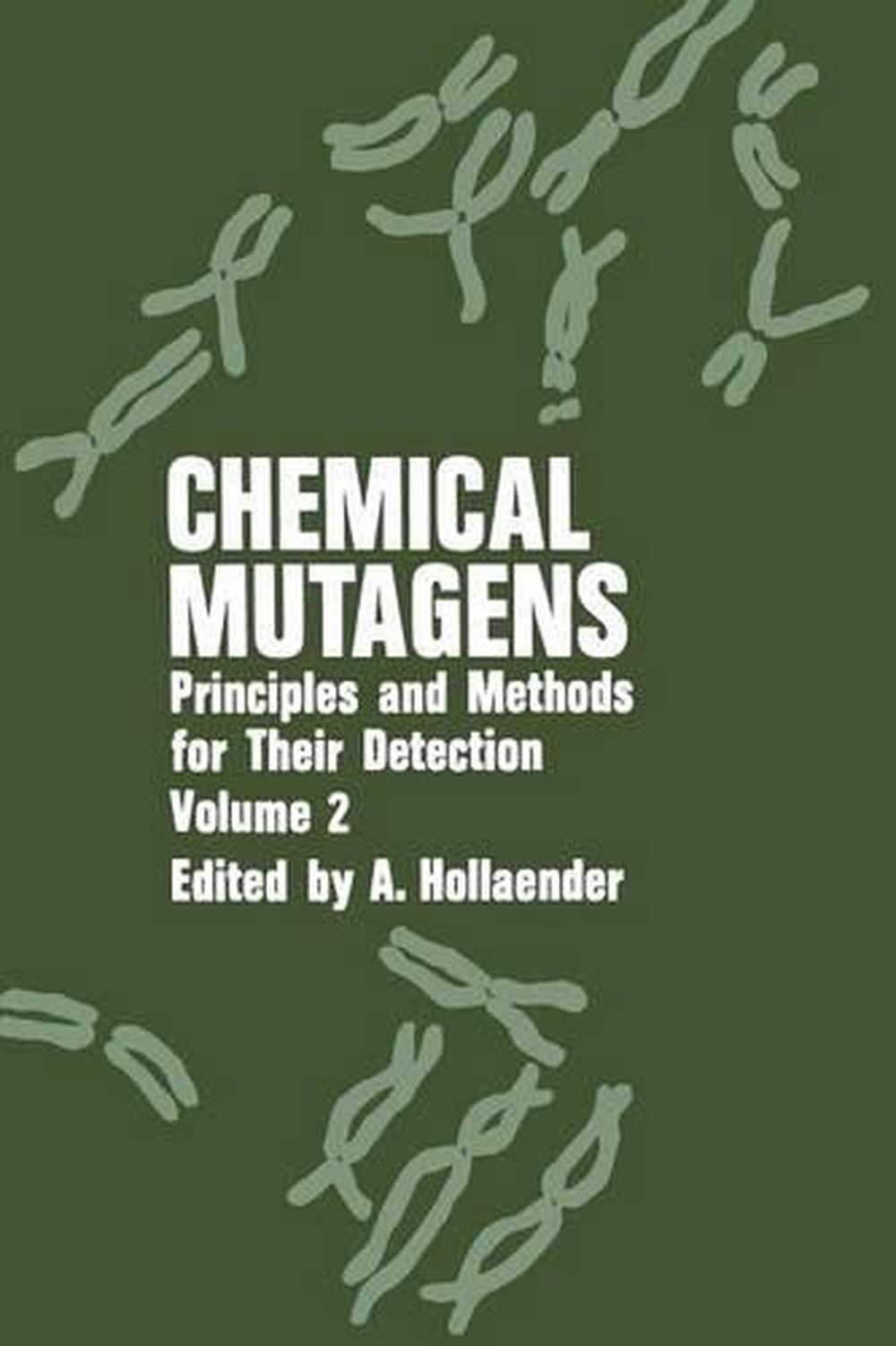
When you click on links to various merchants on this site and make a purchase, this can result in this site earning a commission. Affiliate programs and affiliations include, but are not limited to, the eBay Partner Network.
Chemical Mutagens: Principles and Methods for Their Detection: Volume 2 by Alexa

- Item No : 135783745476
- Condition : Brand New
- Brand : No brand Info
- Seller : the_nile
- Current Bid : US $132.31
-
* Item Description
-
The Nile on eBay

Chemical Mutagens
by Alexander Hollaender
For this reason, I think that somatic tests are preferable to germinal tests, despite the fact that it is germinal mutations which are feared.
FORMAT
PaperbackLANGUAGE
EnglishCONDITION
Brand New
Publisher Description
The best protection against environmental mutagens is to identify them before they ever come into general use. But it is always possible that some substance will escape detection and affect a large number of persons without this being realized until later generations. This article considers ways in which such a genetic emergency might be promptly detected. A mutation-detecting system should be relevant in that it tests for effects that are as closely related as possible to those that are feared. It should be sensitive enough to detect a moderate increase in mutation rate, able to discover the increase promptly before more damage is done, responsive to various kinds of mutational events, and designed in such a way as to maxi mize the probability that the Gause of an increase can be found. Methods based on germinal mutation necessarily involve enormous numbers of persons and tests. On the other hand, with somatic mutations the individual cell becomes the unit of measurement rather than the in dividual person. For this reason, I think that somatic tests are preferable to germinal tests, despite the fact that it is germinal mutations which are feared.
Notes
Springer Book Archives
Table of Contents
of Volume 2.- 11 Measurement of Recessive Lethal Damage Over the Entire Genome and at Two Specific Loci in the ad-3 Region of a Two-Component Heterokaryon of Neurospora Crassa.- I. Introduction.- II. Measurement of the Genetic Effects of Mutagenic Treatment.- III. Characterization of Presumptive ad-3 Mutants.- IV. Media and Chemical Solutions.- V. References.- 12 Aspergillus.- I. Introduction.- II. Life Cycle and Genetic Analysis.- III. Mutation.- IV. Conclusions.- V. References.- 13 Higher Plants.- I. Introduction.- II. Test Systems.- III. Compounds Tested for Mutagenic Activity by Treatment of Seeds.- IV. Special Techniques That Have a Higher Resolving Power.- V. General Evaluation.- VI. Acknowledgments.- VII. References.- 14 Procedures for Culturing Diploid Cells and Preparation of Meiotic Chromosomes from Dwarf Species of Hamsters.- I. Introduction.- II. Background Information.- III. Handling the Diploid Cell.- IV. Spermatogonial and Meiotic Chromosome Preparations.- V. Bone Marrow Biopsy Procedure.- VI. Discussion.- VII. Acknowledgments.- VIII. References.- 15 Induction and Analysis of Gene Mutations in Mammalian Cells in Culture.- I. Introduction.- II. The Cell Material.- III. Utilization of In Vivo Markers.- IV. Detection of Recessive Mutations in Cell Cultures.- VI. Characterization of Newly Isolated Variants.- VII. Procedure for Mutation Induction.- VIII. Concluding Remarks.- IX. Acknowledgments.- X. References.- 16 Inducing Mutations with Chemicals in Habrobracon.- I. Introduction.- II. Maintenance of Habrobracon and Ephestia.- III. Scheme for Mutational Analysis.- IV. Application of Mutagens.- V. Conclusions.- VI. References.- 17 The Detection of Mutations in Drosophila melanogaster.- I. Introduction.- II. Advantages of Drosophila as a Test Organism.- III. Limitations of Drosophila as a Test Organism.- IV. Lethal Tests.- V. Tests for Recessive Visible Mutants.- VI. Tests for Chromosomal Rearrangements.- VII. Tests for Loss of X or Y Chromosomes.- VIII. Tests for Dominant Lethals.- IX. Tests for Half-Translocations.- X. Staging of Germ Cells.- XI. Techniques for Collecting Flies of a Desired Sex.- XII. Review of Literature.- XIII. Summary.- XIV. References.- 18 Root Tips for Studying the Effects of Chemicals on Chromosomes.- I. The Material.- II. Treatment of Root Tips with Chemicals.- III. Fixation and Staining of Root Tips.- IV. Scoring of Slides and Types of Aberration.- V. Comparison Between the Effects of Chemicals on Chromosomes in Root-Tip Cells and in Cultured Animal Cells.- VI. Acknowledgments.- VII. References.- VIII. Suggested Reading.- 19 Cytogenetic Studies in Animals.- I. Introduction.- II. Experimental Design.- III. Classification of Chromosomal Aberrations.- IV. Localization of Chromosomal Aberrations.- V. Timing of Chromosomal Damage.- VI. Meiotic Studies.- VII. In Vivo and in Vitro Studies.- VIII. Specific Techniques.- IX. Summary.- X. References.- 20 Specific Locus Mutation in Mice.- I. Introduction.- II. The Method, Its Advantages and Disadvantages.- III. Results Obtained.- IV. Conclusions.- V. References.- 21 Dominant Lethal Mutations in Mammals.- I. Introduction.- II. The Dominant Lethal Syndrome.- III. The Estimation of Dominant Lethals.- IV. The Genotypes of Dominant Lethals.- VI. Dominant Lethals in Female Germ Cells.- VII. General Validity of the Dominant Lethal Test.- VIII. Synergistic Effects.- IX. Review of Chemicals Tested as Dominant Lethal Mutagens in Mammals.- X. Integration of the Dominant Lethal Assay and Other Mutagenicity Tests into General Toxicological Practice.- XI. References.- 22 TheHost-Mediated Assay, a Practical Procedure for Evaluating Potential Mutagenic Agents in Mammals.- I. Introduction.- II. Materials and Methods.- III. Results.- IV. Conclusion.- V. References.- 23 Human Population Monitoring.- I. Introduction.- II. A Classification of Mutational Effects.- III. Criteria for a Mutation-Monitoring System.- IV. Some Ways of Amplifying the Mutation-Detecting Power of Monitoring Systems.- V. Monitoring for Germinal Mutations.- A. Monitoring for Dominant Mutant Phenotypes.- B. Biochemical Monitoring.- VI. Summary.- VII. References.- Conclusion.- Author Index.
Promotional
Springer Book Archives
Long Description
The best protection against environmental mutagens is to identify them before they ever come into general use. But it is always possible that some substance will escape detection and affect a large number of persons without this being realized until later generations. This article considers ways in which such a genetic emergency might be promptly detected. A mutation-detecting system should be relevant in that it tests for effects that are as closely related as possible to those that are feared. It should be sensitive enough to detect a moderate increase in mutation rate, able to discover the increase promptly before more damage is done, responsive to various kinds of mutational events, and designed in such a way as to maxi
Details
ISBN1461589711Language EnglishYear 2012ISBN-10 1461589711ISBN-13 9781461589716Format PaperbackShort Title CHEMICAL MUTAGENS SOFTCOVER REMedia BookImprint Springer-Verlag New York Inc.Place of Publication New York, NYCountry of Publication United StatesEdited by Alexander HollaenderDEWEY 636.089Subtitle Principles and Methods for Their Detection: Volume 2Illustrations XXII, 342 p.DOI 10.1007/978-1-4615-8969-3AU Release Date 2012-09-10NZ Release Date 2012-09-10US Release Date 2012-09-10UK Release Date 2012-09-10Author Alexander HollaenderPages 342Publisher Springer-Verlag New York Inc.Edition Description Softcover reprint of the original 1st ed. 1971Publication Date 2012-09-10Alternative 9780306371028Audience Professional & Vocational


-
- The Lost Super Foods
- $ 37.00
- The Self-Sufficient Backyard
- $ 37.00
- A Navy Seals BUG IN GUIDE
- $ 39.00
- Childrens Books Phonics Lot 60
- $ 34.99
















